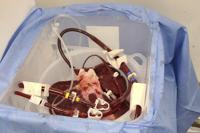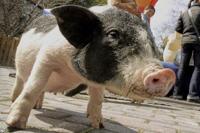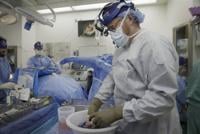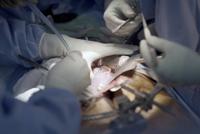WASHINGTON (AP) — On this episode of The Story Behind the AP Story, we hear from Lauran Neergaard and Shelby Lum, who have been following the journey of animal to human transplants, or xenotransplants, over the last few years. That includes sharing the procedure’s history, more about the people who have received these organs and what risks it may pose.
Shelby Lum, Associated Press: There’s more than 100,000 people on the transplant list, and most of these people are waiting for a kidney. Thousands will die on the list before ever being eligible to get one. And many experts say that there will never be enough human donors.
Haya Panjwani, Associated Press: That’s why scientists are turning to a procedure known as xenotransplantation.
Lauran Neergaard, Associated Press: A fancy word to say animal to human organ transplant.
PANJWANI: I’m Haya Panjwani. On this episode of The Story Behind the AP Story, we hear from Lauren Neergaard and Shelby Lum, who have been following the journey of xenotransplants over the last few years. Lauren says xenotransplantation has actually been tried for many, many years, unsuccessfully.
NEERGAARD: There were a number of chimpanzee transplants back in the 1960s. Probably the most famous of them was Baby Faye in 1984, who lived for 21 days with a baboon’s heart. They didn’t work because back then, doctors and scientists hadn’t really understood exactly how you could overcome the challenge of the immune system. The human immune system immediately recognizes those animal organs and the animal tissue as foreign and attacks.
So if you just took a pig’s organ, any old pig organ, and stuck it in a person on the operating table, it would literally turn black before the surgeon’s eyes. That’s how fast the immune system would attack it. Now, what’s happening is we have companies that are gene-editing pigs. They are modifying the genes in pigs so that they are born lacking some of those molecules that say, “attack me” to the human immune system, and with some additional human genes to make them more compatible with people.
They are already used in, well, we’ve used them for food, but they’re also already used in human medicine in a variety of ways. We get heart valves from pigs. We get skin grafts from pigs, and their organs are very compatible to human organs in the anatomy. They look like human organs, they work like human organs, the blood vessels are in the right place that you can attach them properly.
PANJWANI: Shelby says they’ve been able to meet some of the pigs used in these procedures.
LUM: And these pigs are bred specifically to be more compatible for human size, but they look like normal pigs. They look exactly like what you would think of a normal pig to look like. The pigs at the research farm are used for some of the early xenotransplant experiments. So these are for some of the decedent studies where these organs are being tested in brain dead donors, as well as some of the early compassionate care cases.
NEERGAARD: We really started seeing the first examples of organs from these gene-edited pigs being tested in brain-dead donors. And so kidneys from pigs were placed in them to see what happened. And this is where Shelby got to do something really cool.
LUM: I got the chance to be in the operating room for this really experimental surgery to test the pig kidney in this brain dead donor whose name is Moe. Moe’s family had graciously decided to donate his body to this research to see if this could work. In order to do that, we worked with the university for months, which included sending over my vaccination history. It included getting testing done. I had to get blood work drawn to make sure that I wasn’t bringing in anything into this operating room.
So once you’re in the operating room, it’s pretty similar to a regular kidney transplant surgery. You have the surgeon who’s starting the surgery and then surgeons go to the farm and they procure the pig kidney there. And so they fly it back to NYU where the surgery is being done. And in that surgery, they put the pig kidney into the donor. And it turns pink immediately, which is the big sign for a kidney transplant surgery. That’s what you wanna see, is this moment where that kidney turns pink. And it was this really incredible moment where the surgeons attached the kidney, you hear all of them chattering, and you hear them say, It’s pink.
NEERGAARD: What was really amazing was how quickly this moved from deceased bodies into living people.
PANJWANI: In January 2022, a man named David Bennett became the first person to receive a pig heart transplant.
NEERGAARD: And Dr. Bartley Griffith, who was the surgeon involved here, told us how nervous he was about broaching it and then how this patient responded with humor. He said, you know, what do you think I’m gonna oink? That first operation, that first transplant, lasted only two months.
PANJWANI: The second pig heart attempt with a Navy veteran named Lawrence Faucette also only lasted a little less than two months.
NEERGAARD: Then the kidneys started.
PANJWANI: A man named Rick Slayman and a woman named Lisa Pisano both received gene-edited pig kidneys.
NEERGAARD: Those two patients also died. So this is a point where the doctors are like, ‘Whoa, we’re not having as much success as we wanted.’ And they started looking for patients who were not quite so critically ill as those first four people.
An Alabama woman named Towana Looney has lived the longest with a gene-edited pig kidney. She had it for 130 days before her doctors at NYU had to remove it earlier this month. Looney had been doing very well. She had told us she felt like superwoman. But then, at the beginning of April, her body began rejecting the organ. She’s recovered from the surgery and is back home on dialysis again, disappointed, of course. But that record time living with the pig kidney did provide valuable information to scientists.
So what’s next? A New Hampshire man received a pig kidney at Mass General Hospital in January. Like Looney, he was not as sick as some of the prior recipients when he was transplanted, and so far, so good. Chinese researchers also recently announced a pig kidney transplant there, so this is gaining momentum.
LUM: Looney issued a statement saying the outcome wasn’t what anyone had hoped for, but she’s hoping that it can inspire others in this journey as xenotransplantation is studied more. And there are people who are very interested in getting a xenotransplant.
PANJWANI: With any new scientific procedures, there come risks.
NEERGAARD: So one of the risks, of course, is that this will fail. The doctors will all say those first four were actually not failures because of how much they learned from each one of those patients. They will tell you those are names that will go down in medical history because they learned from each and every one of them. The other side of the risk, though, is the fact that we are using animal organs in people. And that does come with concern about whether there would be any possible transmission of animal viruses to people. One of the ethical challenges is whether these people are fully consenting to an experiment. Because so far, they have been people who really have been out of other options. There also are some ethical issues about how the animals are treated, how we’re using animals for the good of humans. And so that’s something that the proponents of this believe is helped by the fact that we’re using pigs, which are also used for food already.
LUM: Lauren and I have talked with a few people who have expressed interest in getting one. Because for so many people living on dialysis, being in the chair several times a week, it is just not the best quality of life. They don’t feel good, they aren’t able to do the things they want to, and so there are people who are really interested in being part of these early studies.
NEERGAARD: I think the main theme that we’ve heard from all of the patients that we have managed to speak with so far, or their families, or even in the case of Moe, the man whose body was used for that early experiment that lasted two months, there’s this common theme that whatever happens to them, they hope that this will teach the surgeon something and the scientist something so that eventually this will work and help other people. That’s every person that Shelby and I have talked to has said that. The Food and Drug Administration has given United Therapeutics permission to do a clinical trial using pig kidneys created by their subsidiary Revivacor Incorporated on a small number of participants. They’ll do surgeries on the first few patients, see how it goes, they’re there for a few months and then they’ll ramp up to larger numbers.
PANJWANI: This has been The Story Behind the AP Story. For more on AP’s health coverage, visit .














































